In this article, I am going to show you exactly how you can find profitable keywords that drive you consistently new leads or sales for your business, in a step-by-step process.
In fact, I have used these exact steps to generate high-quality B2B sales leads with organic traffic of less than 1,000.
(In the graph below there are missing 9 organic leads, that reach out to us via email or phone, so in total it is 23 organic leads from Google and then 2 leads from Bing. So in total 25 organic leads with less than 1,000 organic traffic.)

And without further due, let’s get with finding profitable keywords for your business.
Step #1: Understand your Target Audience Buyer Journey
The first step to find profitable keywords is to understand your target audience and what is their buyer journey.
If you want to drive sales with your content, you must help your target audience to buy. It means you must provide the essential information that supports the completion of critical activities necessary to make a purchase.
Whether you are in B2B or B2C, your buyers are researching to learn more about your products before they make any purchase. And the more expensive the product is, the more information and research need to be completed.
With that being said, first, you must create your target audience. I know you must hear this one many times, but it’s really hard to market when you don’t know who.
That is why first figure out what is their pains and needs and how your product can solve those problems.
Once you know who you market, then it is time to map your buyer journey. Essentially there are four stages of the buyer journey:
- Awareness Stage: That is when your prospects start asking questions about the pains and needs, they are experiencing. For example, “why is my pc slow?” or “how to find profitable keywords?”
- Consideration Stage: That is when your prospects define their problems and searching for options to solve them. For example, “best gaming RAM “or “best keyword research tools”
- Intent Stage: That is when your prospects know what they need, but they need to know more about the specific product or service and validate their decision. For example “xtreem ram review“ or “SE Ranking vs SEMRush”
- Purchase Stage: That is when the prospect is searching for the best deal. For example, “cheap xtreem ram” “SE Ranking pricing”.

Obviously, the most profitable keywords are at the Consideration, Intent & Purchase Stage. Often these keywords will be long-tail keywords as they tend to be more specific.
However, it is highly recommended when you do keyword research to have keywords for all stages of your buyer journey to maximize your exposure and potentially influence your reads to choose you and not your competitors.
And keywords for the brand awareness stage often have the largest search volume and most of the keywords you’ll find will be for brand awareness.
Step #2: Understand the Search Intent
The second step of finding profitable keywords is to understand the search intent.
The search intent means the reason behind the search query.
In general, 99% of SEO keywords, you’ll find can be categorized into four different types of search intent:
- Informational: This is when a searcher is looking for information. Often this could be relevant to your product or service. For example “how to do keyword research” if you are selling SEO products or “how to fix a computer” if you are selling computer components. These keywords have often very little value as search is not searching to buy but learn.
- Navigational: This is when a searcher is looking for a specific brand. For example “Amazon”, “SE Ranking”, or “BMW”. These keywords can be extremely valuable for resellers but hard to rank for.
- Commercial: These keywords are often used when a searcher is looking for a specific product or service but needs to learn which one is the best. Often these keywords feature words like “best, top, review, comparison or attribute + product name”. A few examples could be: “best keyword research tools”, “SE Ranking Review, “blue BMW”, “iphone 13 vs samsung s22”. These keywords are the golden ones.
- Transactional: This is when a user is searching to make a purchase. They have enough information, they know what they want, and only what they need to find now is the best deal. For example, such keywords could be: “SE Ranking discount”, “SE Ranking pricing”, “iPhone 13 coupon”, or “BMW Sweden”

You might also notice that the search intent aligns with the buyer’s journey.
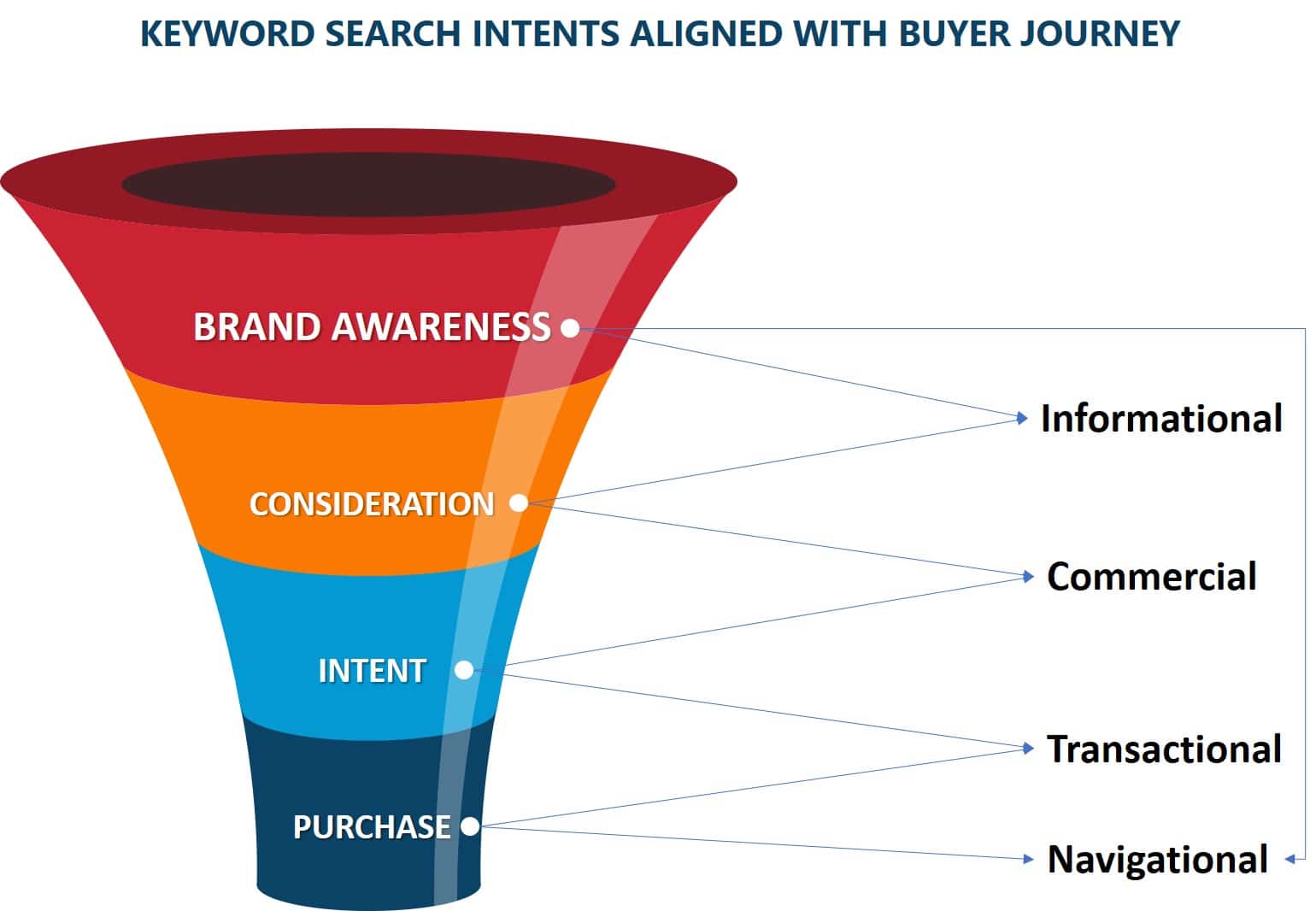
With that, now you understand the principles of what makes keywords profitable. Remember, organic traffic doesn’t pay the bills and one of the main reasons why you were not driving any leads, sales, or affiliate sales could be because all your keywords were focused on information search intent.
Step #3: Generate Seed Keywords
The third step is to generate seed keywords relevant to your niche.
Seed keywords are short queries with one or two words with broad meanings. Any keywords with general meaning are often seed keywords.
An example of a seed keyword could be “car”. However, this is a very bad seed keyword example because it is too broad and it will be very hard to cover enough topics so Google can associate your website with the keyword because there are millions of relevant keyword ideas for this seed keyword.

Therefore, a good seed keyword example could be “electric cars” or “hybrid cars”. This is still a broad keyword with high search volume, but you narrow down your targeted niche and you have a much better chance to find profitable keywords and become the authority for this broad/seed keyword, despite it has higher ranking difficulty.

Of course, this depends on your market and your niche. But the more specific you can go with seed keywords the better. Just think of the seed keyword as a broad topic you want to own in SERPs. The reason why is because you want to focus on creating topic clusters.
I will not go into many details about topic clusters but simply said, your seed keyword should be broad enough so you can create additional 20-30 posts under this seed keyword.
Here is an example of a topic cluster based on the keyword “electric car” being the seed keyword.
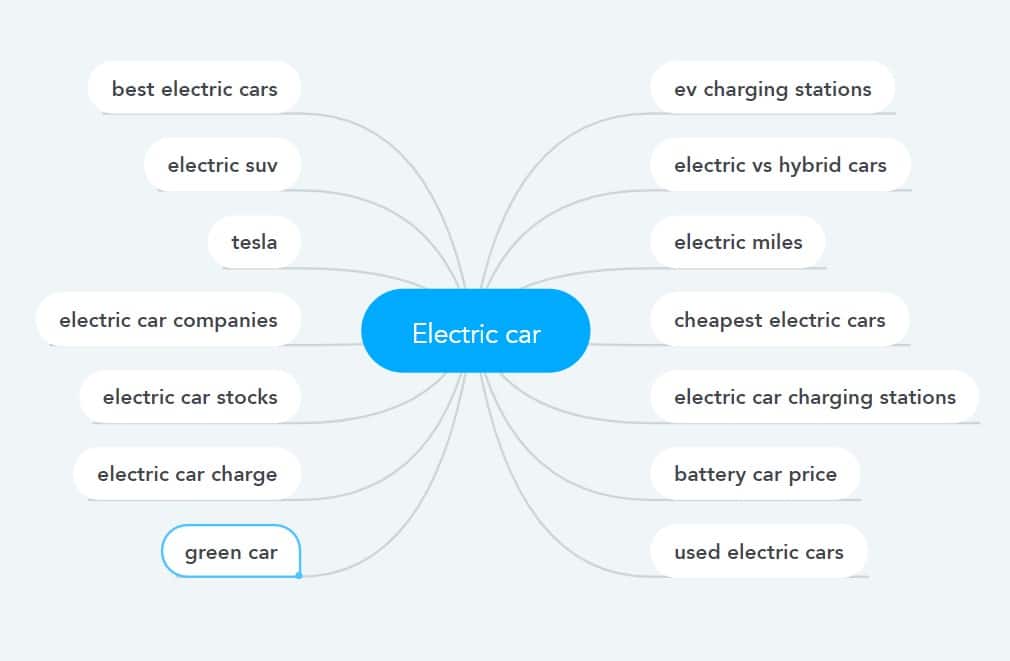
With that, here are some of my favorite ways to generate seed keyword ideas:
Technique #1: Seed Keyword Associated with Your Website
The first and the best way to start discovering seed keywords is your own website if you have one and you have been creating content on it. If not, then you can skip this.
There are two ways, how you can discover seed keywords on your website, so let’s start with the first using SEO tool like SE Ranking.
With that let’s suppose my domain is greencars.com to stay with the theme. So, to discover seed keywords Google associates my website with, I go to SE Ranking Competitive Research tool, enter my domain with targeted location, and hit analyze.

And here I’ll get useful information about the domain such as the domain trust, organic traffic, and organic keywords. So, I click on the number of keywords.
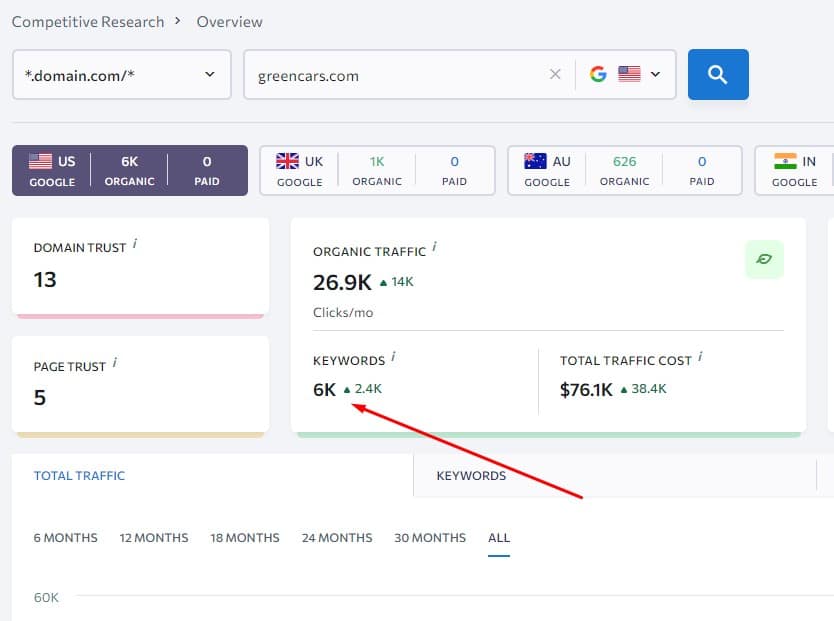
And here I have the total list of all keywords my domain is ranking for. So, now I only have to scan those keywords to find any seed keywords.
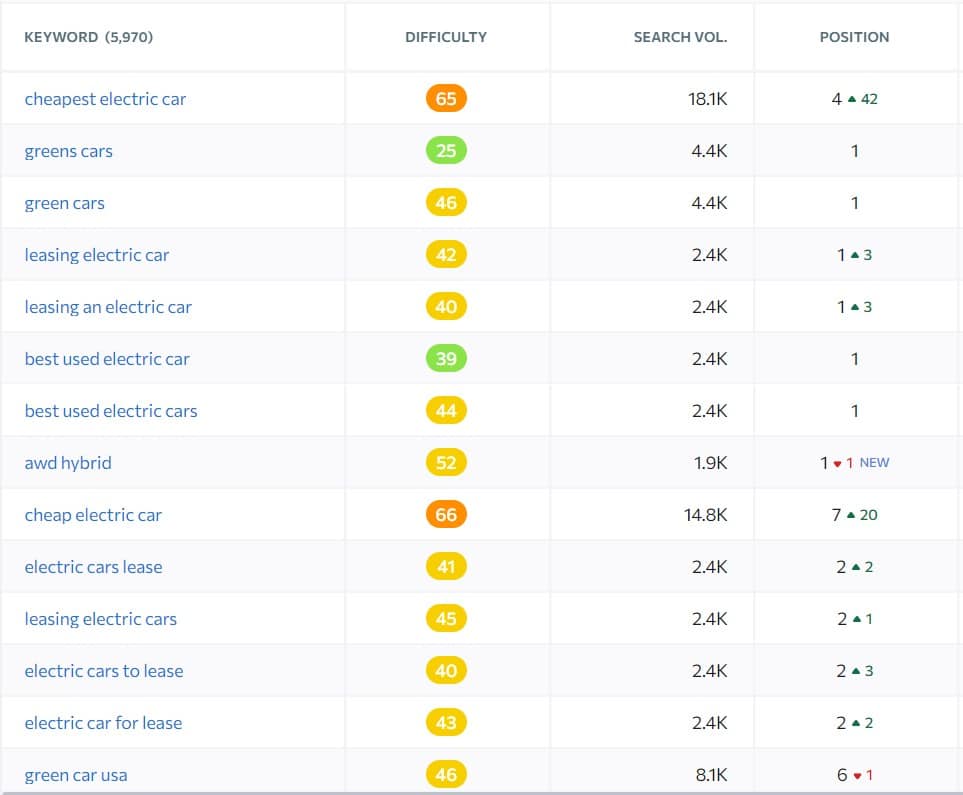
And right away I can see seed keywords like “green cars” or “awd hybrid”. These keywords are great because I already know Google associate my website with these seed keywords. Thus, if I keep expanding my topics around these seed keywords, I know I can rank well.
The second place where you can find seed keywords is in your Google Search Console dashboard, in the Performance report.

Technique #2: Competitor Seed Keyword Research
The second technique to find seed keywords is from your competitors’ websites.
The problem with the first technique is that you must have already content on your website around your seed keywords to see it. However, if you want to get new ideas, the best place is from your competitors’ website.
So, to see who my competitors in SE Ranking are, I click on the “Competitors” report under the Organic Traffic research tab.

And here I can find all my competitors. Of course, I want to avoid any large news size such as “usnews.com” or “consumerreports.org” as these sites are not focusing on my niche but are very broad.
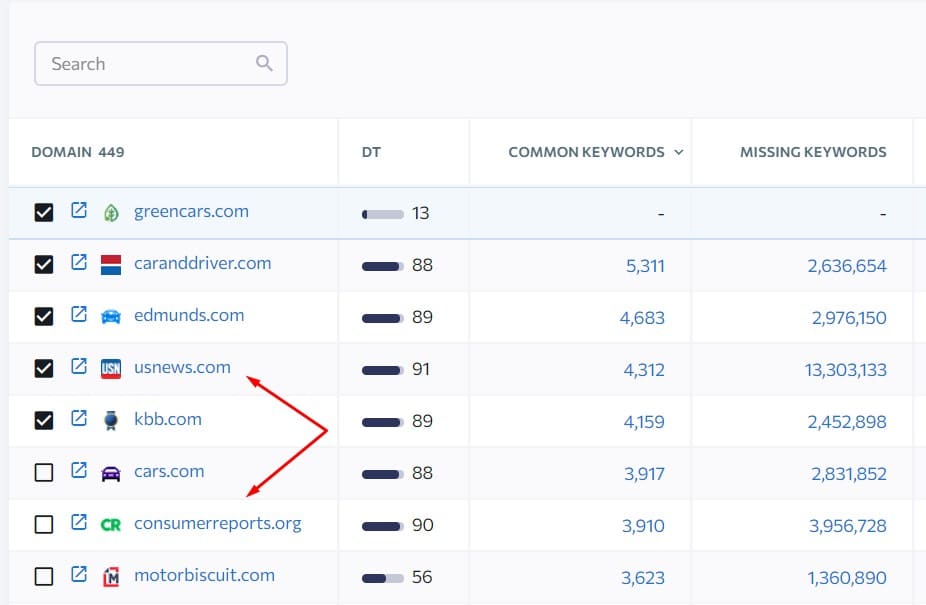
Instead, I want to find sites that are specifically in my electric car/green car niche. So, domains like “drivingelectric.com” or “electrek.co” are great because they are in my niche and have high authority with a lot of content and keywords to choose from.
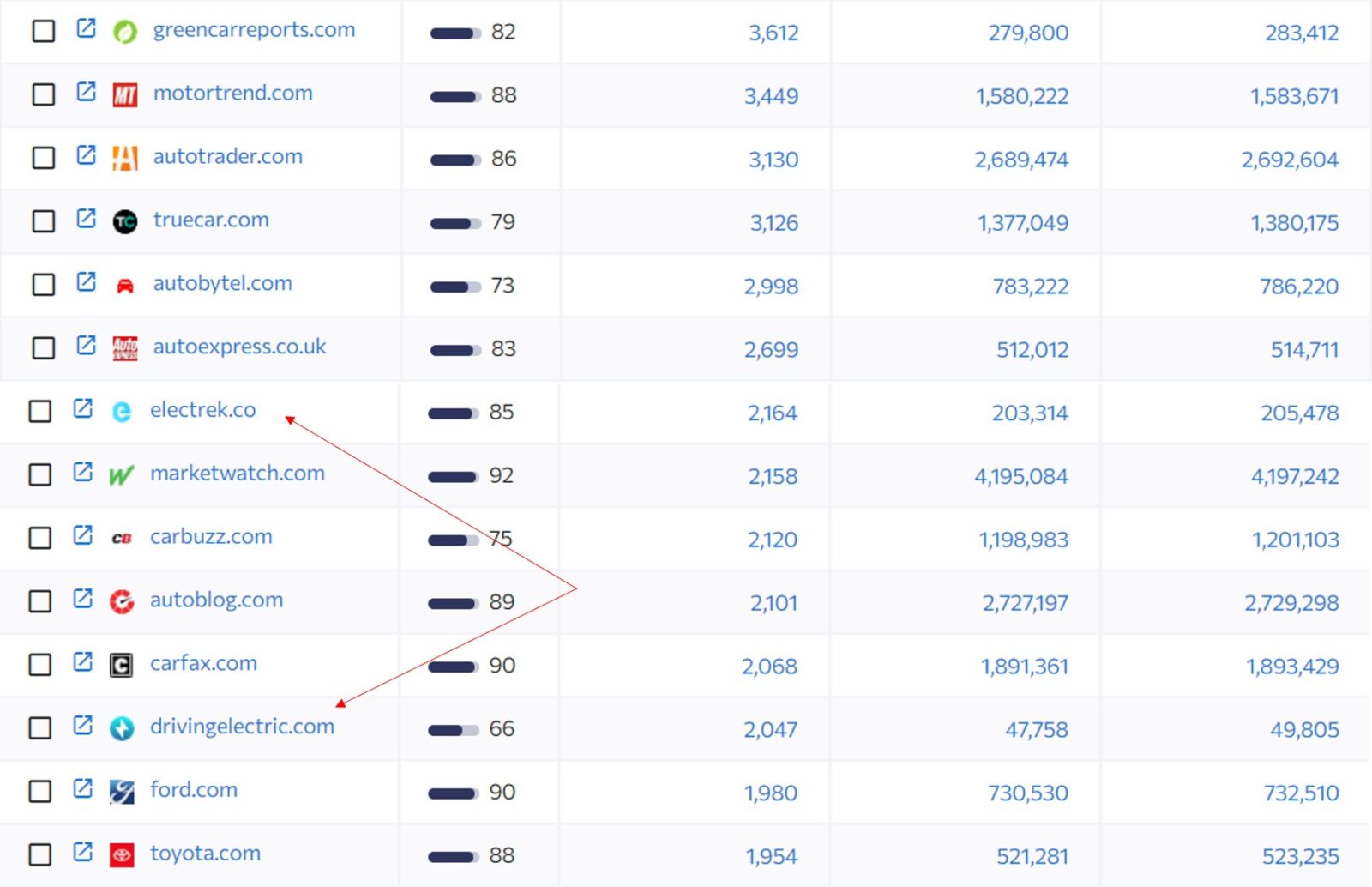
So, once I have these domains, I can open them in the SE Ranking Competitive Research tool and open up their total keywords report to find seed keywords the same way as with the first technique.

Just scan their keywords and find those seed keywords that are relevant to your niche. For example, if I wanted to expand my reach, I could choose the keyword “electric motorcycle”.
Remember, you can also use this technique to find a list of keywords that you can target. In step #4 I will show you how to generate a list of keywords to your seed keyword, but this technique works great as well to generate a list of keywords related to your niche.
Technique #3: Wikipedia Pages in Your Niche
The third technique is to use a Wikipedia page to find seed keywords and relevant topics to your niche.
Wikipedia is an excellent place to find relevant topics for your niche. Just looking at the Wikipedia page for Car, you can find plenty of topics and seed keywords that you can talk about.

As you can see on the Wikipedia page, I have the seed keyword “electronic cars” that I’ve shown you could be a perfect seed keyword if I want to be in the automobile industry.
Each topic you can see here is a great example for seed keywords. However, it is still important to stay in your niche. For example, if you want to talk about air pollution, then you should talk about only how cars polluting the air or anything in that relevance.
Remember, it’s always important to stay relevant to your niche regardless of the topic.
Technique #4: Google
The next place where you can find seed keywords is on Google.
As you probably know, this fancy tool can give you a lot of information and ideas if you are using it right and there are a lot of ways to generate seed keywords.
So, to start with searching seed keywords, first I need to come up with some topics. Let’s stick with the broad topic “car” and let’s see if we can find the seed keyword “electric car” again.
The first way is to search for industry terms. To find them you can use any of these queries, modify them, and pop them into Google.
- “Industry” terms
- “Industry” vocabulary
- “Industry” keywords/key terms
- “Industry” Terminology
- “Industry” Dictionary
For example:
- Car Terms
- Automotive vocabulary
- Car keywords
- Vehicle Terminology
- Transportation Dictionary
So, if I search for “car terms” I get glossary and terminology pages with a list of potential seed keywords relevant to my niche and topic.

And if I click on the first result, I’ll get all the information I need to find seed keywords Also, I found the seed keyword “electric car”.

Alright, and the second way to find seed keywords on Google is using Google Keyword Planner.

Just go to Keyword Planner, click on “Discover new keywords” and enter your topic or niche. I will use the word “car” again. Also, I choose my targeted location/s and hit get results.
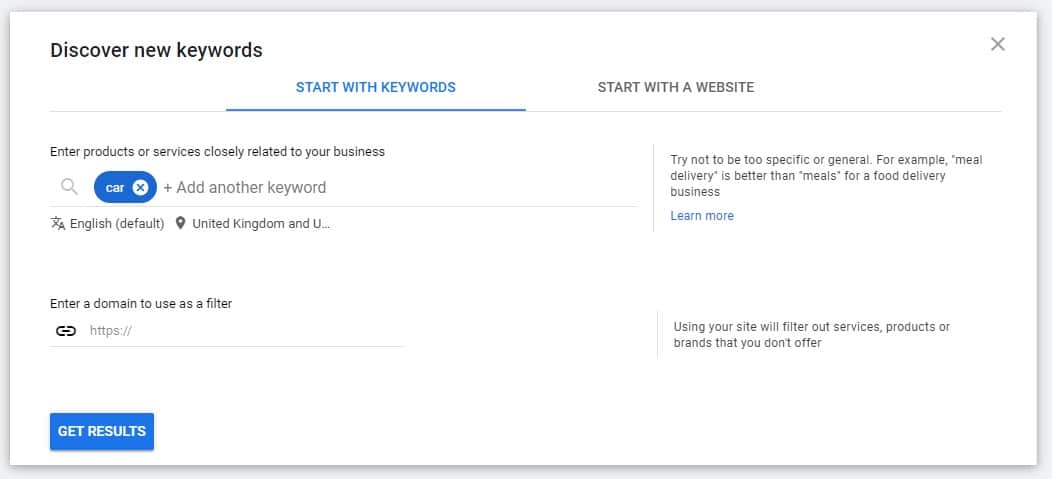
And here you can find plenty of seed keyword ideas as well. But for some reason, I couldn’t find the keyword “electric car”.

However, you can also use Keyword Planner to find keywords for your seed keywords as well which will discuss in step #4.
With that, these are the four techniques you can use to find seed keywords. Of course, there are more ways to get seed keyword ideas such as using chrome extensions like Keywords Everywhere or SEO Minion, online tools like SeedKeywords.com, or using industry podcasts and books.
Either way, these techniques could give you already enough seed keyword ideas, so it’s time to move to the next step of finding profitable keywords.
Step #4: Generate a List of Keywords to Your Seed Keyword
The fourth step of finding profitable keywords is to generate a list of relevant keywords to your seed keyword.
The reason why you want to first find a seed keyword is that as I showed you before, you want to treat each keyword as a topic and then find a subtopic to improve your topic signals and create topic clusters.
Like this, you give a strong signal to Google what is your website about so it can rank your website accordingly. This will help you to reduce your ranking fluctuation.

With that, to start generating a list of keywords you need to use a keyword research tool. There are plenty of keyword research tools out there and each of them has its pros and cons.
But my favorite keyword research tool is from SE Ranking because they have one of the largest keyword databases in the market with over 3+ billion keywords, their interface is super intuitive and user friendly and most importantly they offer by far the best value for money.
So, if you want to give it a spin, use my link here to get 14 days trial and see for yourself how SE Ranking will boost your ranking.
Alright, to start I go to SE Ranking Keyword Research tool and enter my seed keyword. Let’s stick with the “electric cars”. Also, I choose my targeted location and hit analyze.

Then, I open the “Similar Keyword” report. This report essential gives me alternative keywords that are close in meaning to the analyzed search query.
I like to use this report when I am searching for subtopics for my seed keywords and LSI keywords when I am preparing articles.
Also, it helps me to find the most relevant keywords as this is super important when I am creating a new website and want to establish authority for one topic. However, when I am expanding and searching for new ideas I use the “Related Keywords” report.
Either way, both are great places to find keyword ideas and generate a list of keywords, but let’s start with the first “Similar Keyword” report.
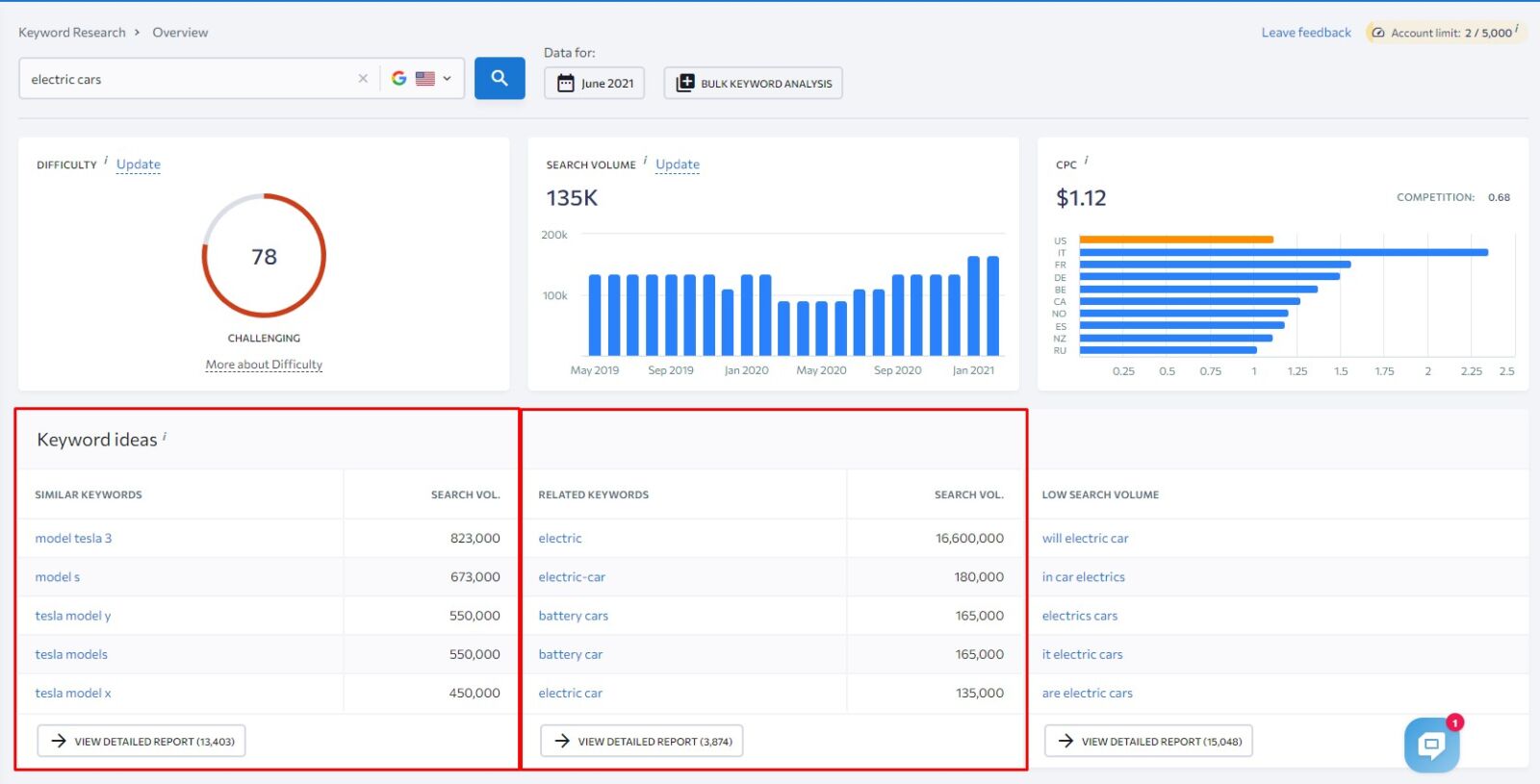
And here I have my list of keywords closely related to my seed keyword. Now, because I have over 11 thousand keyword ideas which is way too many keyword ideas to manually go through it, I will also set some filters.

The first filter I recommend set is the “Search Volume” filter. However, how to set this filter highly depends on the analyzed keyword.
For example the list of keywords for the analyzed keyword “electric cars” has the highest search volume of 180k, so I can set the “Search Volume” filter to something high like 1,000 and I still got almost 700 keyword ideas.
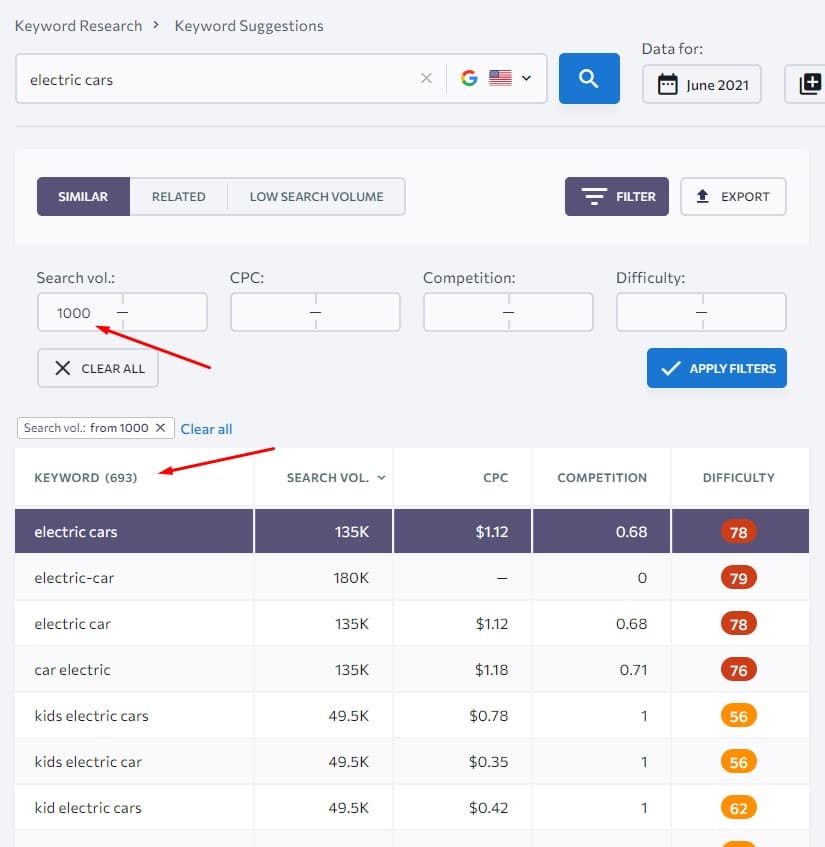
But analyzed keyword like “email marketing” has only 18k search volume for the highest keyword. Thus, I might set it lower like 200 and I get around 200 keyword ideas.
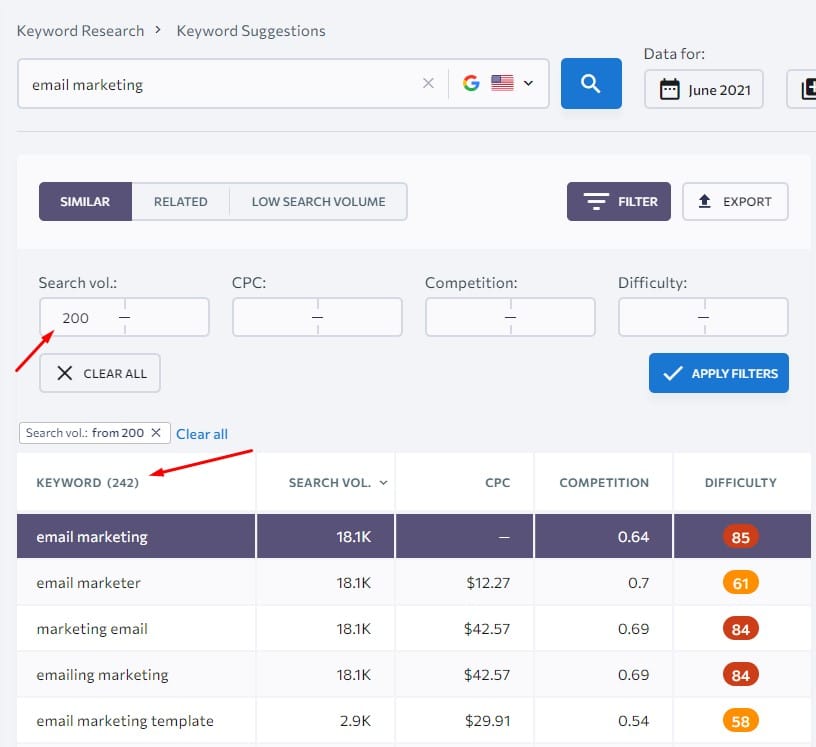
And the second filter is keyword difficulty. This depends on your website’s overall authoritativeness. But if you are starting then I recommend you to start with something low and set the “Difficulty” filter to max 30.
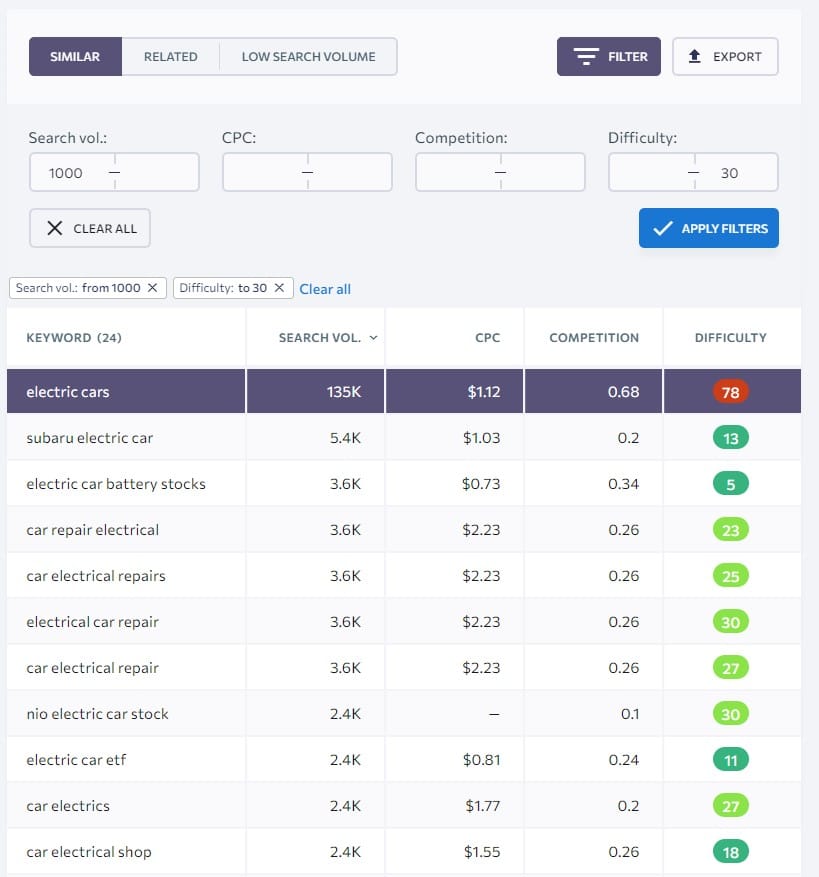
Alright, now I am down to about 20 keyword ideas from almost 700. Huge drops like this often happen when the seed keyword is too competitive.
This means you will need to build more backlinks to rank for this topic or choose a less competitive seed keyword at first. Remember to outrank your competitors you’ll need at least the same amount of high-quality backlinks as your competitors.
One last thing, remember, as I said, you can also use the competitor keyword research technique to generate a list of keyword ideas.
Step #5: Map Keywords at MOFU & BOFU Stage
The fifth step of finding profitable keywords for your website is to map keywords that are at the middle (MOFU) and bottom of the SEO funnel (BOFU).
Yes, each keyword can be profitable regardless of the buyer’s journey. However, this is a good place to start as keywords at the bottom and middle of the funnel indicate that buyers are close to making a purchase decision.
But it is optimal to have keywords across all the stages of the buyer journey as at the beginning you can influence your users and they can get familiar with your brand, which could be the decisive moment whether prospects buy from you or your competitors.
However, because we are searching for profitable keywords, then let’s look at how you can identify keywords from your generated list of keywords at the middle of the funnel and bottom of the funnel.
But before let’s revisit the buyer journey funnel aligned with the search intent to better understand what the middle of the funnel and bottom of the funnel is.
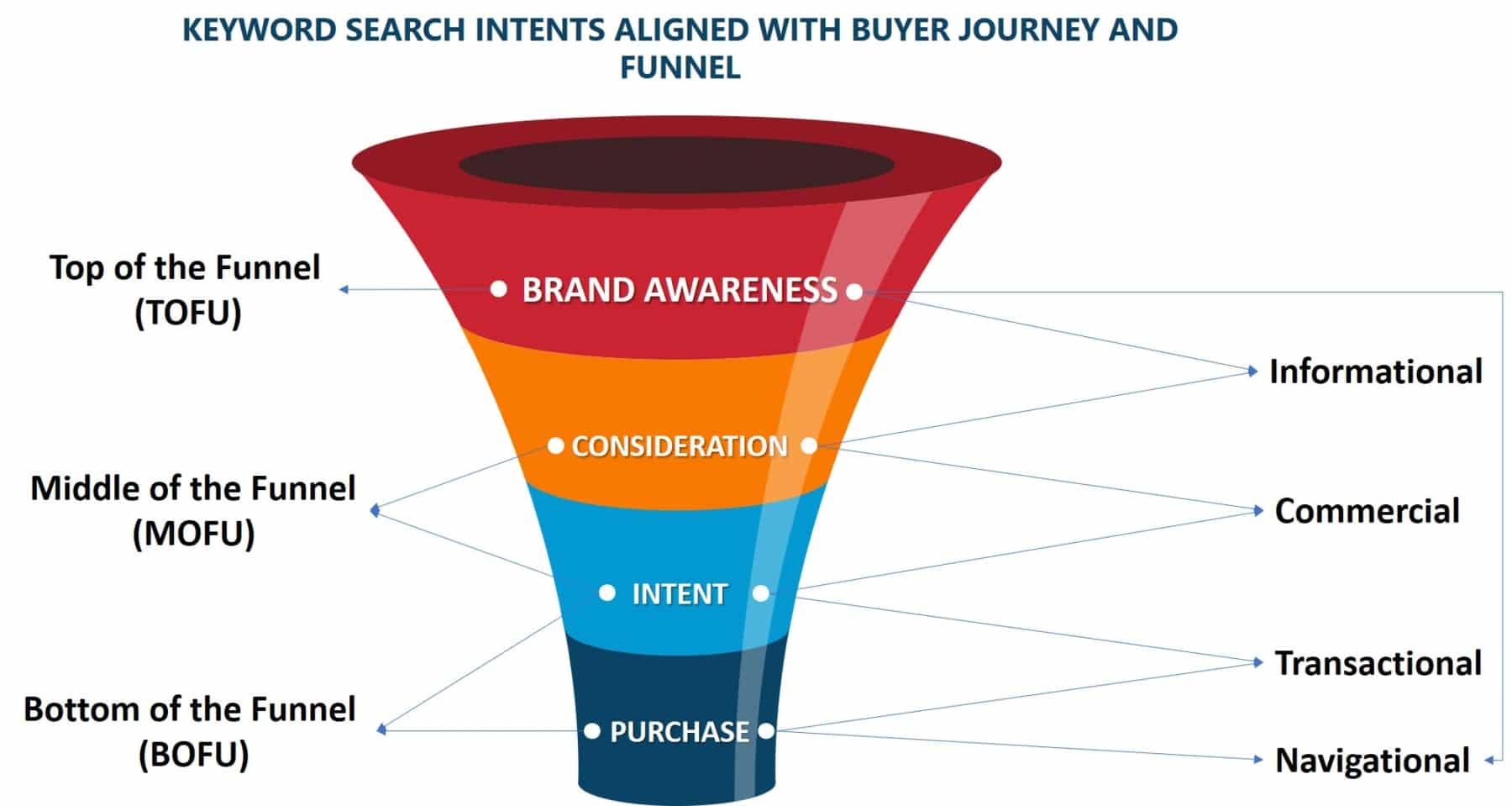
As you can see, the keywords in the middle and bottom of the funnel are mainly commercial, transactional, and then also navigational search intent keywords.
So now, let me show you how you can scan your list of keyword ideas. Also, I have removed the keyword difficulty filter for my analyzed keyword “electric cars” just for the sake of having more keyword ideas for demonstration purposes.
However, I strongly recommend you stick with the keyword difficulty. You can always generate more seed keywords and subsequently get a bigger list of keyword ideas.
How to Analyze Keyword Search Intent
Before we move to find keywords at the MOFU and BOFU stage, first you must understand how to analyze keyword search intent.
So here are 3 steps to determine search intent
Step #1: Check Keyword Modifiers
The first step to identify keyword search intent is to check the keyword modifiers.
Here is a table of keyword modifiers that typically indicate a certain type of search intent:

This will help you to speed up the process of finding profitable keywords as you can see it just from the keyword itself and the headlines of content in the SERP what is the search intent.
For example, the keyword idea “best electric cars” can be assumed to be a commercial type of keyword, and the keyword “bmw electric car” is a navigational type of keyword according to the table.

We will validate it in the next step, as the table isn’t foolproof and not all keywords contain modifiers. Also, some keyword ideas are having the same parent topic, which means the same web page can appear for different keywords.
Step #2: Analyze the SERP
The second step to determine keyword search intent is to analyze the search engine result pages (SERPs).
The thing is, Google is spending billions of dollars to figure out the user search intent, and depending on the results you can pretty accurately determine the search intent.
In SE Ranking, next to the keyword list you can find the Organic SERP report where you find the top Google search results for any selected keyword.
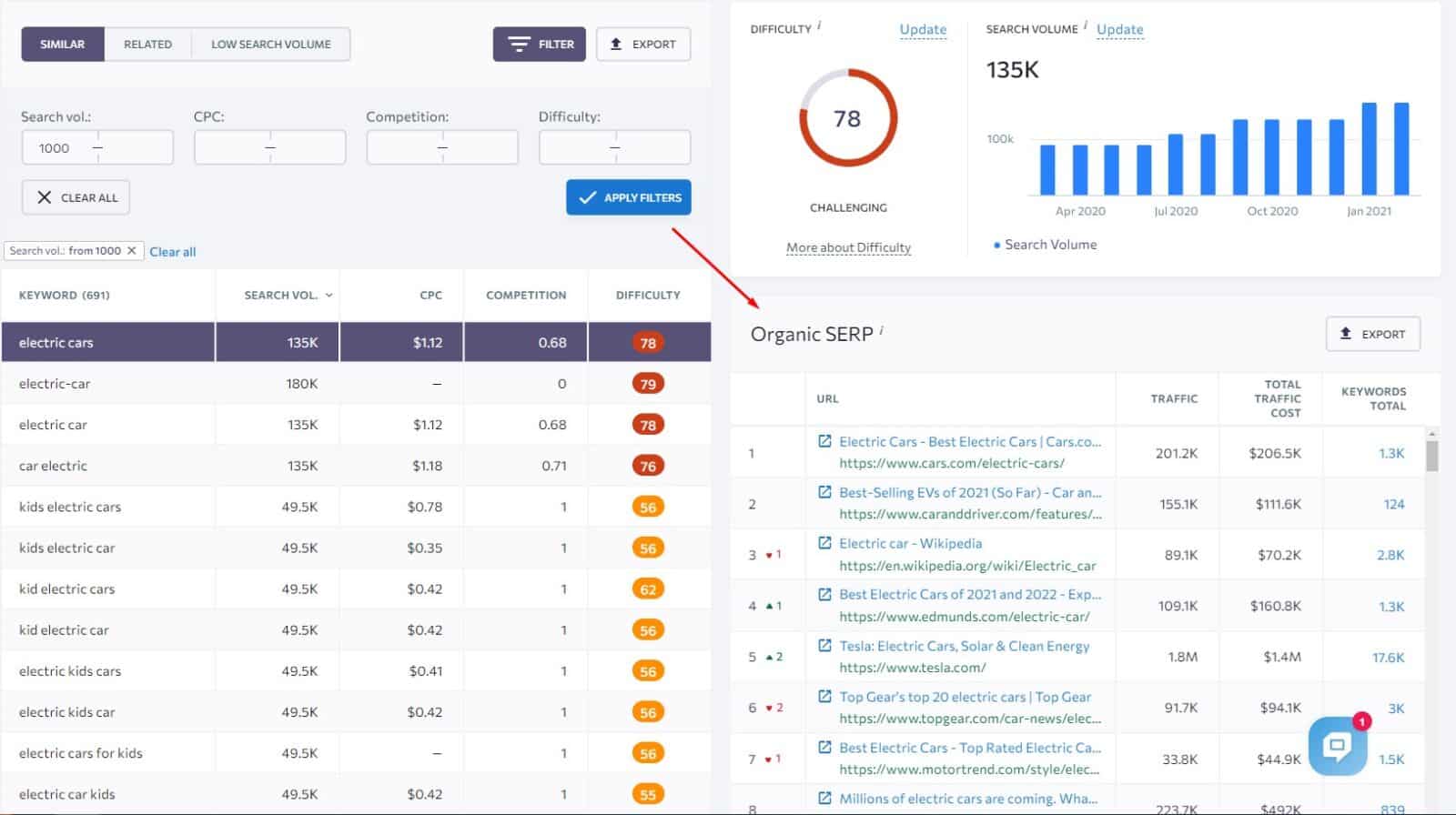
However, you can do this exercise while using just Google, but bear in mind that the SERP is depending on the location where you at. So, if you target a different location, then you can use the free tool from SE Ranking Google Location Changer.

But I will be using the SE Ranking Keyword Research to determine the keyword search intent
For example:
- The analyzed keyword “electric cars” is mainly a commercial type of keyword but it is also a bit informational because mostly the SERPs display a list of the best electric cars, but you can also see Wikipedia page and some news sites.

And on Google, you can see the content box, which shows that Google sees this keyword as a commercial, but not transactional because there are no ads.

- Another keyword could be “kids electric cars”. This keyword is transactional mixed with commercial search intent because the search results mainly show product category pages from Amazon or Walmart, but then you can also see the best list that indicates commercial intent.

And when I open Google I can see Content Box for products which tells me, Google sees this keyword mainly as a transactional keyword.

- And the last keyword example is “electric cars tax credit”. This keyword is informational because in SERP you can see an informational type of content like articles and support pages and most of the pages has the keyword modifiers like “what” or “how”.

As you can see, Google can show you what is the keyword search intent, thus, shows you whether the keyword is profitable or not.
Also, it’s common for keywords to be in between search intents. However, when you look at the top 5 positions typically there are 3 results out of 5 that show the dominant search intent.
Step #3: Check CPC of the Keyword (Check Google’s Special Content Resources Blocks)
And the last step to determine the search intent and whether the keywords are profitable or not is to look at the CPC.
Typically the higher the CPC the higher is the commercial or transactional intent. However, what is high or low depends on the niche. For example for the seed keyword “electric cars,” I see a high CPC is around $4.
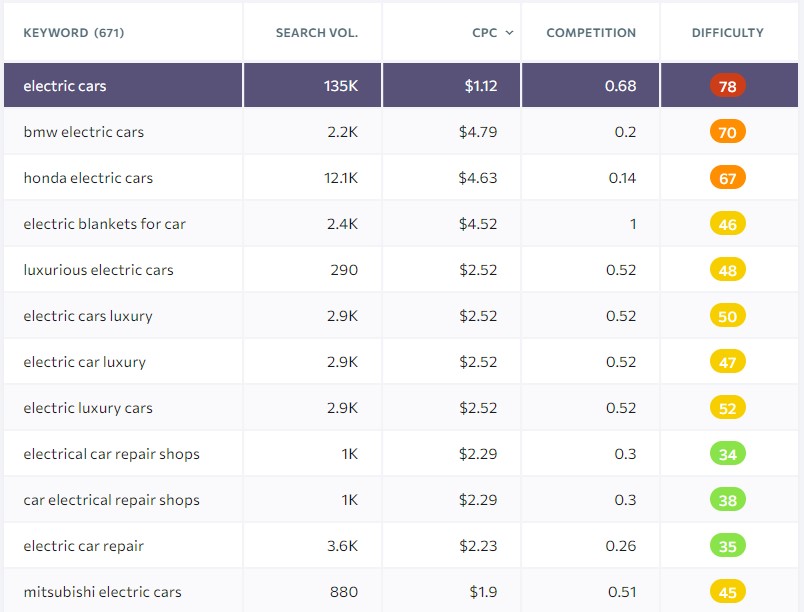
However, in other niches, the keywords can have different pricing. For example, the Law niche is known for one of the highest CPC.

This is a great indicator to find out whether the keyword is profitable or not and whenever I am searching for new profitable keywords, I like to sort the keywords by highest CPC in SE Ranking.
Alright, now when you understand how to analyze keyword search intent, it’s easy to find keywords for MOFU and BOFU stage.
MOFU
So, let’s first find profitable keywords for the middle of the funnel stage or based on our marketing funnel for the consideration and intent stages.
I expect this will be easy because the analyzed seed keyword “electric cars” is already commercial and transactional keyword. This is because the keyword is a category of a product.
It’s common that the list of keyword ideas being predominantly made of commercial and transactional keywords, if your seed keyword is a product or service category, then it will be easy to find profitable keywords.
However, if I would be analyzing seed keywords with information intent, like “SEO” then most of the results will be informational and I will need to do some digging to find profitable keywords at the MOFU and BOFU stages.
With that, to find keywords at the MOFU stage, I will be scanning the keywords one by one and looking at the Organic SERP report in SE Ranking to find keywords that feature the keyword modifiers “best, top, review, etc.” and the content type being list of electric cars or category pages.

And right away I can see keywords like “electric cars luxury”, “electrical car repair shops”, or “electric car leasing deals”.

These keywords are commercial keywords because they have commercial keyword modifiers like “best, top, deals, etc. and the Organic SERP shows pages with a list of products or category pages plus they have high CPC.
Also, the keyword “gas cars vs electric cars” is a commercial keyword. However, at a very early stage as the user is searching for a product, but still, the content is more information as they need to decide which direction to go.
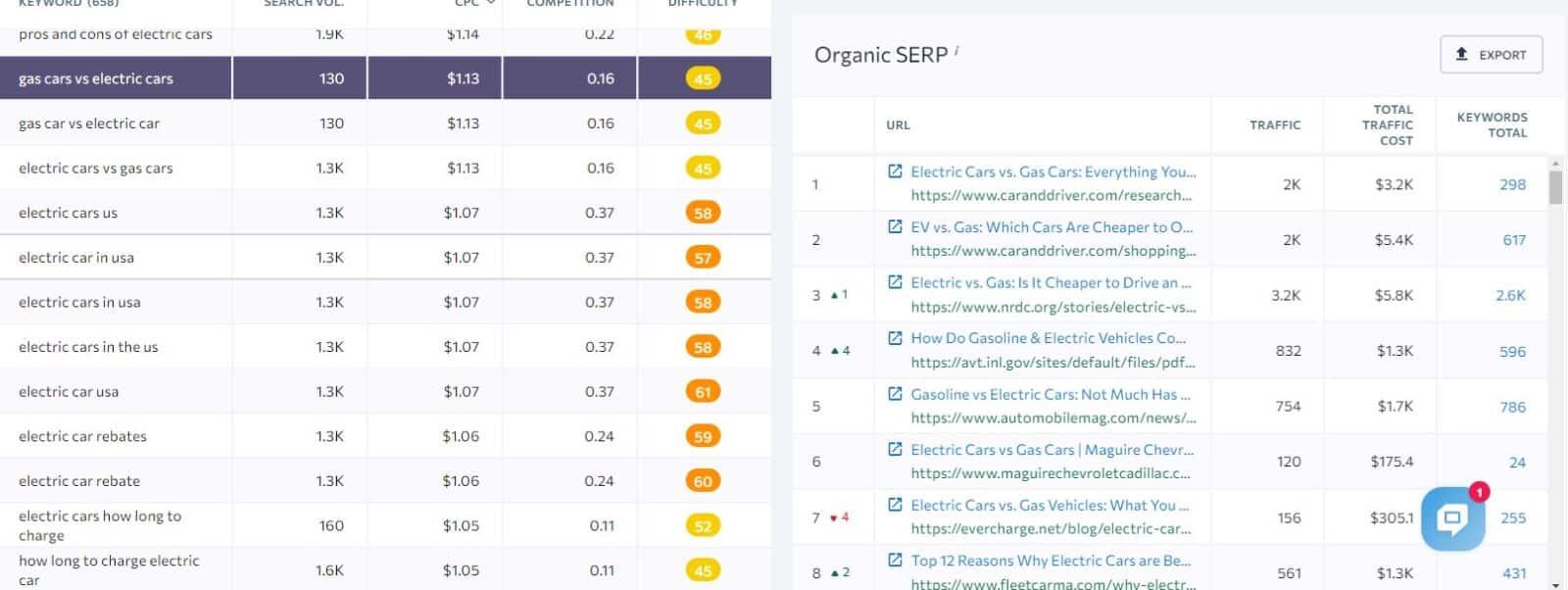
And if I keep scanning I would find more profitable keywords with commercial search intent.
BOFU
And to find profitable keywords for the BOFU stage I will do the same thing, but I will be looking at transactional keyword modifiers along with navigational keyword modifiers like “brand name”, “cheap”, “buy”, etc.

And I can see that there a lot of keywords with brand names like “bmw electric cars” or “honda electric cars”. But the keyword “bmw electric cars” shows transactional search intent because the Organic SERP report shows product and category pages on the top.

And the keyword “honda electric cars” shows information search intent because the organic search results show a lot of article and information content.

So, you need to be careful and look at each keyword individually as not always the same type of keyword yields the same organic results.
And other keywords for the BOFU stage can be “most affordable electric cars” or “cheapest electric car”.

These keywords are transactional as they show the user is searching for cheap electric cars to buy, thus the results are pages with a selection of cheap cars on the marketplace. From here, the users can start searching for branded keywords once they find an electric car that fits their budget and needs.
But remember, the search intent can change and for example, the keyword “honda electric cars” can become a commercial or transactional keyword in the future.
That’s why you need to keep constantly monitoring your keywords to ensure you are targeting the keywords with the right type of content and pages.
Because one day users prefer to see a product page, so you create a product page to target the keyword and suddenly the next day the users prefer informational content like a blog article, then your product page becomes obsolete.
Thus, it is very common to target the same keyword with different content type pages to target the different search intents in case the search intent fluctuates. Like this, you can rank for the keyword with the right content whenever the search intent changes.
Back to You
Finding profitable keywords is just one piece of the puzzle for an effective SEO strategy for B2B, but it is very important.
Remember, that organic traffic doesn’t pay the bills and you need to focus on generating leads with your SEO and Content Marketing strategy and if you are driving a lot of organic traffic but not any leads, then you need to revisit your strategy.
I saw websites with 100k monthly organic traffic and driving 30 MQL every month and then I saw websites with 2,000 monthly organic traffic and driving 20 MQL every month.
Of course, you want to target keywords with high search volume to boost your brand awareness. However, you need to be focusing on generating B2B sales leads first to ensure you are bringing sales so you can sustain your business.
That’s why I hope this guide on how to find profitable keywords will help you to increase your SEO lead generation.
Related Articles:
- 7 Powerful B2B SEO Tips: SEO for Beginners to Rank #1 on Google in 2022
- Ultimate On-Page SEO Guide for Non-SEOs to Boost Organic Traffic & Ranking
- SEO Competitor Analysis: How to Beat SEO Competitors [+Template]
- How to Do a Content Audit for B2B Website? To Increase Organic Traffic, Leads & Ranking
- How to Write SEO Content: Learn How to Rank #1 in Google
- 101+ B2B SEO Statistics You Should Know in 2022
- How to Find Keywords on a Website
- Content Gap Analysis: The Ultimate Guide
Also, check out our SEO hub page to find all our SEO resources.
Disclaimer
Some pictures are coming from Freepik and some of my links are affiliate links, which means if you purchase something, I might get some small commission as a reward for reference. Of course, I am actively using all these services and products, and I only affiliate products or services I have full trust in their quality!








